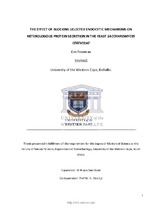| dc.description.abstract | The yeast Saccharomyces cerevisiae is considered a good host used for heterologous protein production due to the organism’s microbial safety, rapid growth and eukaryotic post- translational processing. As a fermentative organism, S. cerevisiae is thus not only a useful platform for the production of biopharmaceuticals and industrial enzymes, but also a promising organism for second-generation biofuel production. Substantial effort has been focused on alleviating the many bottlenecks in recombinant gene expression, as well as in the secretory pathway to enhance heterologous protein titres. It was recently shown that highly active endocytosis could decrease the overall secreted protein titre in the supernatant. In this study, we aimed to block endocytotic and vacuolar complexes to ultimately disrupt, or impair, the endocytotic and vacuolar mechanisms of proteolysis and test the effect that this would have on secreted heterologous protein titres. This was accomplished by knocking out various genes involved in endocytosis and transforming the strains with genes encoding various hydrolases including β-glucosidase (Bgl), xylanase (Xyn2), endoglucanase (Eg2) and cellobiohydrylase (Cbh1). Our study demonstrated that genetic blocking of endocytotic mechanisms as well as vacuolar complexes could theoretically improve heterologous protein secretion in S. cerevisiae. Endoglucanase (Eg2) titres displayed improvement of 26% and 30% in strains which had the RVS161 and VRP1 genes deleted and xylanase titres displayed an improvement of 71% and 143% in strains with the END3 and SSA4 gene deletions. Several of the gene knockouts tested improved Xyn2 and Eg2 titres but the effect of the different gene targets varied widely. A double knock-out strain with deletions in CLC1 and RVS161 secreted 104% more Eg2 than its parental control strain on a per dry cell weight basis, a significant synergistic improvement. Other double knock-out strains displayed additive or similar activities when compared to their controls. Cbh1 secretion could not be improved through the gene deletions tested in our study and Bgl activity could not be measured in our transformants. These results demonstrate the different relationships of various heterologous proteins with various components of the secretion machinery and may also imply how endocytosis as well as vacuolar complexes affect the level of secreted protein. | en_US |

